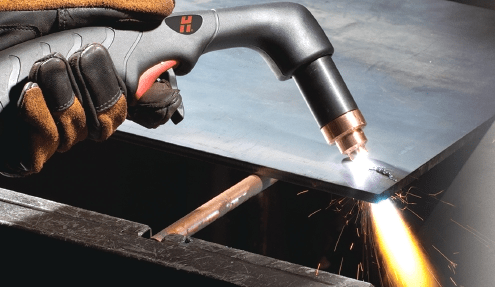One of the types of metal cutting is plasma cutting. A plasma jet is used instead of a cutter.
Plasma is a gas, it is already ionized, has a high temperature and conducts electricity. Cutting occurs as a result of penetration of the material with the help of heat. It is generated by a plasma arc, and the melt is removed by a plasma jet.
The plasma arc is obtained from the usual one. It is formed in the plasma torch when the arc is compressed, and gas is blown into it, forming a plasma. There are two types of cutting: plasma jet cutting and plasma arc cutting.
The arc burns between the tip of the plasma torch and the electrode in the process of cutting with a plasma jet. The processed material is not included in the electrical circuit. An indirect arc action is created. A jet of plasma is taken out of the plasma torch at high speed – this is part of the plasma column of the arc, it is its energy that is used to cut the metal.
When plasma-arc metal cutting is performed, the arc burns between the object being cut and a direct-acting electrode, which is not subject to melting. A plasma jet is formed from a heated and ionized gas, as a result of the action of an arc. For cutting, the combined energy of the torch, the plasma of the column, and the near-electrode spot is used.
The scope of the two methods is different. Plasma-arc cutting is widely used – it is most effective. The plasma jet usually cuts non-metallic materials, since electrical conductivity is not required.
Plasma jet cutting is most cost-effective for processing the following materials:
- copper having a thickness of up to 80 mm;
- aluminum and its alloys up to 120 mm thick;
- cast iron with a thickness of not more than 90 mm.
- carbon and alloy steels with a thickness within 50 mm.
Cutting technology must be observed. During processing, the cutter should be positioned as close as possible to the edge of the material being cut. When the cutter switch button is pressed, the pilot arc is ignited, then the cutting arc, then the cutting itself begins. It is necessary to keep the distance separating the end of the torch tip and the metal being cut unchanged. The arc should be directed at a right angle to the sheet being cut, down. The torch should move slowly and smoothly along the intended cut line. Sparks, when the speed is strictly observed, are visible from the reverse side of the sheet that is being cut. This is evidence that the material is cut correctly and through.
Cutting speed and amperage are of great importance. They must be correctly selected – then the cut will be clean, without deformations and scales. The best option is to perform trial cuts using high current and speed control.
